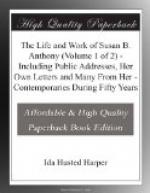On election day the Hutchinsons, Miss Anthony and Mrs. Stanton, in open carriages, visited all the polling-places in Leavenworth, where the two ladies spoke and the Hutchinsons sang. Both amendments were overwhelmingly defeated, that for negro suffrage receiving 10,843 votes, and that for woman suffrage 9,070, out of a total of about 30,000. These 9,000 votes were the first ever cast in the United States for the enfranchisement of women. How many of them were Republican and how many Democratic, and how much influence Mr. Train may have had one way or another, never can be known; but it is a significant fact that Douglas county, the most radical Republican district, gave the largest vote against woman suffrage, and Leavenworth, the strongest Democratic county, gave the largest majority in its favor.
The Commercial, the Democratic paper of this city, said:
When we consider the many obstacles thrown in the way of the advocates of this measure, the indifference with which the masses look upon anything new in government and their indisposition to change, the degree of success of these advocates is not only remarkable, but one of which they have a just right to feel proud. To these two ladies, Susan B. Anthony and Elizabeth Cady Stanton, to their indomitable will and courage, to their eloquence and energy, is due much of the merit of the work performed in the State.... While in the recent election these ladies were not successful to the full extent of their wishes, they have the consciousness of knowing that their work has been commensurate with the combined efforts of party organization, congressmen, senators, press and ministers to enfranchise the negro, and that the people of Kansas are not more averse to giving the franchise to woman than to the black man.
During the campaign the usual order was for Miss Anthony to speak the first half hour, making a clear, concise, strong argument for suffrage as the right of an American citizen, pleading for the negro as well as for the women, and urging men to vote for both amendments. She then was followed by Mr. Train, who insisted that it would be one of the grossest outrages to give suffrage to the black man and not to the white woman, and pleaded earnestly that the women of Kansas should be enfranchised. In this he was sincere, as he believed thoroughly that women ought to have the ballot. He was an inimitable mimic and was unsparing in his ridicule of those Republicans who had battled so valiantly for equal rights but now demanded that American women should stand back quietly and approvingly and see the negro fully invested with the powers denied to themselves. He had a remarkable memory, an unequalled quickness of repartee, a peculiar gift of improvising epigrams and, while erratic, was a brilliant and entertaining speaker. He was at this time about thirty-five, nearly six feet tall, a handsome brunette, with curling hair and flashing dark eyes, the picture of vigorous health. He




